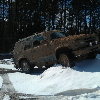2000StreetRod
Moderator Emeritus
- Joined
- May 26, 2009
- Messages
- 10,597
- Reaction score
- 334
- City, State
- Greenville, SC
- Year, Model & Trim Level
- 00 Sport FI, 03 Ltd V8
Advancing the camshafts?
According to an article posted on AA1CAR.com advancing the camshafts a few degrees improves throttle response and low speed torque with minimal degradation of max rpm performance. Jakee mentioned in a post that some of the Mustang SOHC V6 owners advance their camshafts about 5 degrees. Advancing the camshafts would also help compensate for the timing chains stretching and the chain guides wearing down.
Does anyone have an opinion or tried it and have measured results? I don't recall Al Franklin ever discussing it. I'm going to do more internet searching and may try advancing the camshaft timing five crankshaft degrees (i.e. set the crankshaft at 5 degrees before TDC and then align the camshaft timing slots).
Stock camshaft timing:
185 degrees intake duration @ .050,
193 degrees exhaust duration @ .050,
0.472” valve lift with 116 degree lobe separation.
According to an article posted on AA1CAR.com advancing the camshafts a few degrees improves throttle response and low speed torque with minimal degradation of max rpm performance. Jakee mentioned in a post that some of the Mustang SOHC V6 owners advance their camshafts about 5 degrees. Advancing the camshafts would also help compensate for the timing chains stretching and the chain guides wearing down.
Does anyone have an opinion or tried it and have measured results? I don't recall Al Franklin ever discussing it. I'm going to do more internet searching and may try advancing the camshaft timing five crankshaft degrees (i.e. set the crankshaft at 5 degrees before TDC and then align the camshaft timing slots).
Stock camshaft timing:
185 degrees intake duration @ .050,
193 degrees exhaust duration @ .050,
0.472” valve lift with 116 degree lobe separation.










